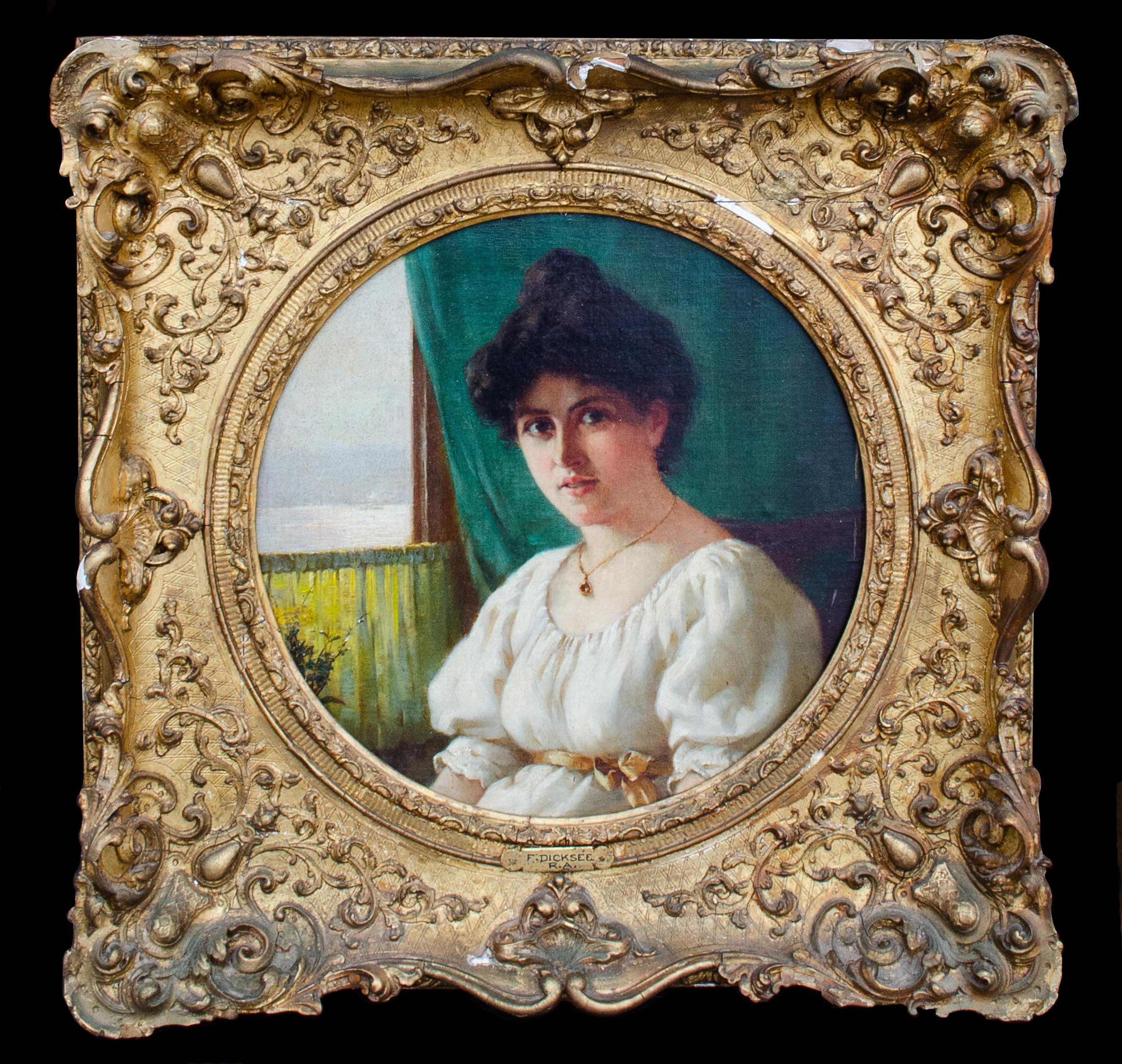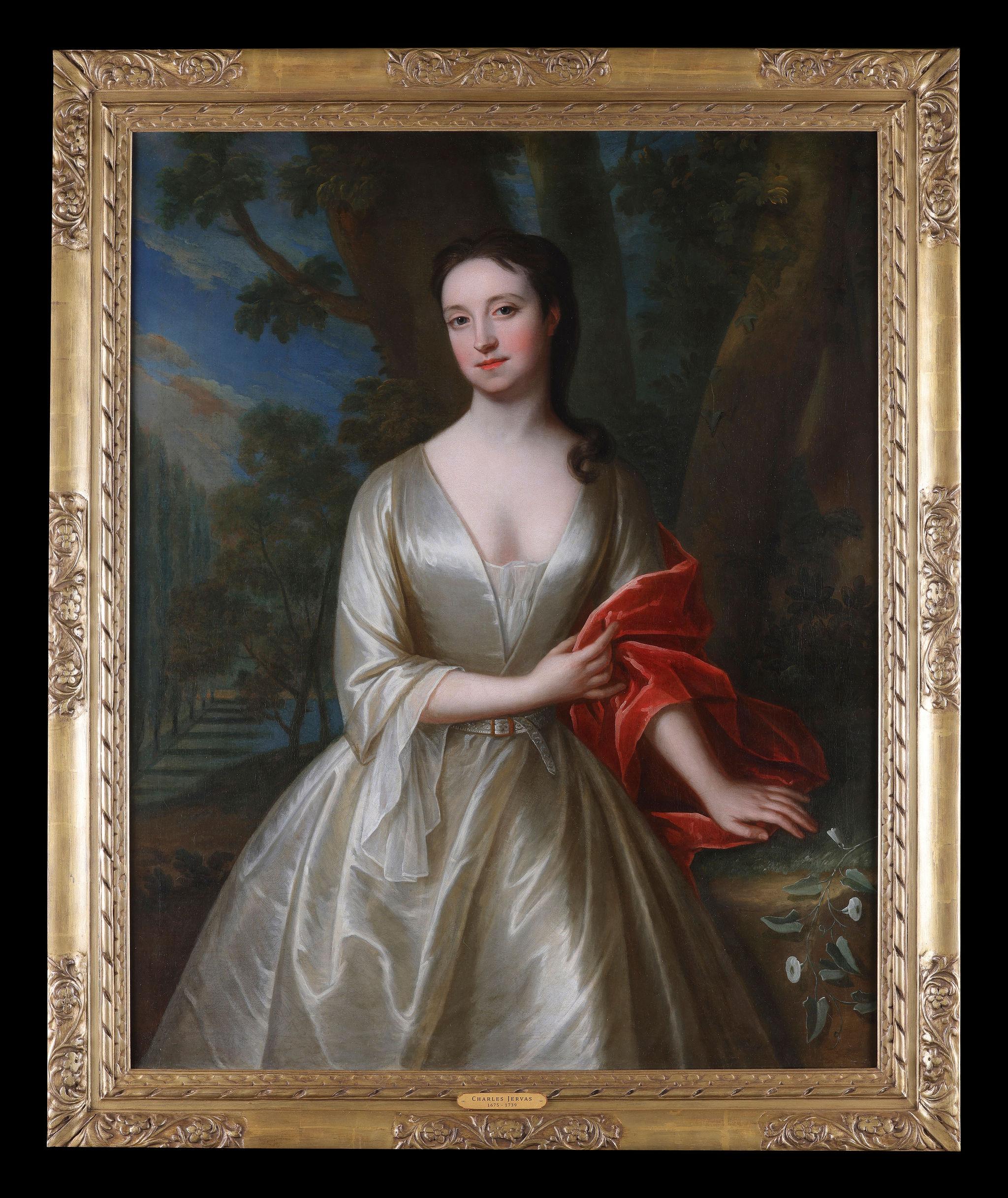Items Similar to 'Sir John Wynn, 5th Baronet' three-quarter-length portrait, oil on canvas
Want more images or videos?
Request additional images or videos from the seller
1 of 8
'Sir John Wynn, 5th Baronet' three-quarter-length portrait, oil on canvas1718
1718
About the Item
Sir John Wynn, 5th Baronet
Canvas Size: 50 x 40" (127 x 102cm)
Outside Frame Size: 58 x 48" (147 x 122cm)
Sir John Wynn, 5th Baronet (1628 – 11 January 1719) was a Welsh landowner and Tory politician who sat in the English and British House of Commons between 1679 and 1713.
Wynnstay Estate, inherited by the 5th Baronet
Wynn was the only son of Henry Wynn of Rhiwgoch, Merioneth, and was educated at the Inner Temple, 1646. He inherited the Watstay Estate through his marriage to Jane Evans (daughter of Eyton Evans of Watstay), which he renamed the Wynnstay Estate. He also, allegedly, won the manor of Stanwardine in Shropshire from Thomas Corbett in a snail race.
He succeeded his cousin Sir Richard Wynn, 4th Baronet as a baronet in 1674 but did not inherit the Gwydyr Estate, which passed to his predecessor's daughter Mary (later wife of Robert Bertie, 1st Duke of Ancaster and Kesteven).
Wynn served as High Sheriff of Denbighshire for 1671–3, as High Sheriff of Caernarvonshire for 1674-75 and as High Sheriff of Merionethshire for 1675–1676. He was Custos Rotulorum of Merionethshire for 1678–1688, 1690–96 and 1700–1711.
Wynn was returned as Member of Parliament for Merioneth in 1679. He was returned again in 1685 and held the seat until 1695. At the 1698 English general election he was returned as MP for Caernarvon Boroughs. At the 1705 English general election he was returned unopposed as MP for Caernarvonshire. He was returned unopposed at the 1708 British general election and the 1710 British general election. He retired at the 1713 British general election.
Wynn lived into his nineties, mainly residing in London, but died without issue in 1719. On his death the Wynn baronetcy became extinct and the ancient House of Aberffraw (which claimed direct descent from Rhodri Mawr ap Merfyn in the late 9th century and through him to the legendary line of Brutus) was left without known male issue.
Wynnstay Estate, Denbighshire, 1879
Had Thomas Jones (Twm Siôn Cati) really been the illegitimate son of John "Wynn" ap Maredudd (as claimed by Sir John Wynn, 1st Baronet in his family history), his children would have been next in line, illegitimate sons having the same rights of inheritance as legitimate ones under ancient Welsh law. There are also several claims that "lost" relatives such as a supposed Colonel Hugh Wynn who is alleged to have moved to Virginia and raised a family.
However, with no clear heir, Sir John bequeathed the entire Wynnstay estate to Jane Thelwall, great-granddaughter of the first baronet and wife of Sir William Williams, 2nd Baronet (c. 1665 – 20 October 1740). Sir John Wynn and Sir William Williams were the two largest landowners in north Wales at that time and together the combined estate dwarfed all others. In honour of his wife's ancestry Sir William Williams changed his name to Sir William Williams-Wynn of Wynnstay.
- Attributed to:John Vanderbank (1694 - 1739, British)
- Creation Year:1718
- Dimensions:Height: 58 in (147.32 cm)Width: 48 in (121.92 cm)Depth: 3 in (7.62 cm)
- Medium:
- Movement & Style:
- Period:1710-1719
- Condition:For a painting over 200 years old it is in very good condition and has benefited from a reline and a light clean. It is in a handmade wooden frame.
- Gallery Location:St. Albans, GB
- Reference Number:1stDibs: LU2469214398022
About the Seller
5.0
Gold Seller
These expertly vetted sellers are highly rated and consistently exceed customer expectations.
Established in 1965
1stDibs seller since 2023
19 sales on 1stDibs
Typical response time: 1 hour
- ShippingRetrieving quote...Ships From: St. Albans, United Kingdom
- Return PolicyA return for this item may be initiated within 7 days of delivery.
More From This SellerView All
- Portrait of a Lady possibly Frances Thynne, Lady Worsley 1673-1750 Oil on canvasBy Charles JervasLocated in St. Albans, GBCharles Jervas Possibly Frances Thynne, Lady Worsley 1673-1750 Oil on Canvas Picture Size: 50 x 40" Outside Frame Size: 58 x 48" 1675 – 1739 Charles Jervas, who was born in Clonli...Category
Early 1700s English School Portrait Paintings
MaterialsOil
- Portrait of a Man possibly Arthur Viscount Irwin, Temple Newsam Oil on canvasBy Charles JervasLocated in St. Albans, GBCharles Jervas Possibly Arthur, 6th Viscount Irwin (Temple Newsam) Oil on Canvas Picture Size: 50 x 40" Outside Frame Size: 58 x 48" 1675 – 1739 Charles Jervas, who was born in Cl...Category
Early 1700s English School Portrait Paintings
MaterialsOil
- A Bewigged GentlemanBy Enoch SeemanLocated in St. Albans, GBEnoch Seeman Oil on Canvas Canvas Size: 30 x 25" (76 x 64cm) Outside Framed Size: 37 x 32" (94 x 82cm) He was born in Danzig, now Gdansk, Poland, around 1694. His father, also En...Category
Late 18th Century English School Portrait Paintings
MaterialsOil
- The Flower GirlBy Louise AbbemaLocated in St. Albans, GBLouise Abbéma 1853–1927 Louise Abbéma (30 October 1853[1] – 10 July 1927) was a French painter, sculptor, and designer of the Belle Époque. Abbéma was born in Étampes, Essonne Born into a wealthy aristocratic Parisian family with close ties to the city’s artistic community, She began painting in her early teens, and studied under such notables of the period as Charles Joshua Chaplin, Jean-Jacques Henner and Carolus-Duran. Portraits of actors and actresses at the Comédie Française dominated her early works until she made a name for herself at the Salon of 1876 with her portrayal of the “Divine Sarah.” Abbéma ultimately executed multiple portraits and received recognition for her work at age 23 a bronze medallion of Sarah Bernhardt, with whom she was a close friend and possibly lover. Like most women artists of the time, Abbéma focused mainly on portraiture and genre scenes (images of everyday life). Her high-society portraits executed with a light touch and rapid brushstrokes reveal the academic and Impressionist influences that shaped her style. Her sitters included French diplomats and other notable members of society. Abbéma developed a variety of techniques using oil paints, pastel, and watercolor, and worked on various supports, including fans. Abbéma received commissions for panels and murals which adorned the Paris Town Hall, the Paris Opera House, numerous theatres including the Theatre Sarah Bernhardt, and the "Palace of the Colonial Governor" at Dakar, Senegal. Abbéma solidified her international reputation after exhibiting works, including two wall murals (on canvas), at the Women’s Building at the 1893 World’s Columbian Exposition in Chicago. A bust of Sarah Bernhardt sculpted by Abbéma was also exhibited at the exposition. Abbéma specialized in oil portraits and watercolors, and many of her works showed the influence from Chinese and Japanese painters, as well as contemporary masters such as Édouard Manet. She frequently depicted flowers in her works. Among her best-known works are The Seasons, April Morning, Place de la Concorde, Among the Flowers, Winter, and portraits of actress Jeanne Samary, Emperor Dom Pedro...Category
1890s Impressionist Figurative Paintings
MaterialsOil
- Portrait of a Gentleman with his Dog - Possibly Abraham Tucker. Oil on CanvasBy Enoch SeemanLocated in St. Albans, GBEnoch Seeman - 1894 - 1744 An excellent example of Seeman's work. It is typically unsigned as was the case of many portraits of that time. A three quarter length portrait showing a r...Category
1730s Old Masters Portrait Paintings
MaterialsOil
- The RoseLocated in St. Albans, GB'The Rose' Canvas Size: 38.5 x 28" (98 x 71cm) Outside Frame Size: 48.5 x 38 (123 x 97cm) Oil on canvas Emile CHARLET 1851 - 1890 Born 1851 in Belg...Category
1870s Impressionist Figurative Paintings
MaterialsOil
You May Also Like
- Portrait of a Young Boy Carrying a Fruit Basket, 18th Century Oil on CanvasBy Sir William BeecheyLocated in London, GBOil on canvas Image size: 30 x 25 inches (76 x 63.5 cm) Hand carved gilt frame This is a charming 18th century portrait of a young boy, sporting a golden child's two-piece with a fl...Category
18th Century English School Portrait Paintings
MaterialsCanvas, Oil
- Sir Francis Dicksee Portrait, c. 1900Located in Larchmont, NYSir Francis Dicksee (English, 1853-1928) Untitled (Portrait of a Woman), c. 1900 Oil on canvas; period frame Sight: 13 1/4 in. Framed: 21 1/8 x 21 1/8 x 3 3/8 in. Frank Dicksee was...Category
Early 1900s English School Portrait Paintings
MaterialsCanvas, Oil
- 18th century portrait of the German Flautist and composer Johann Joachim QuantzBy Arthur DevisLocated in Bath, SomersetPortrait of Johann Quantz (1697-1773), flautist and composer, wearing a blue velvet coat, waistcoat and breeches, standing in a garden landscape with ...Category
18th Century English School Portrait Paintings
MaterialsOil, Canvas
- Portrait of Ann Austen, nee GreyBy Bartholomew DandridgeLocated in London, GBSigned 'BDandridge/ pinxit' lower left Provenance By descent through the sitter's family to The Collection of R. W. Vivian-Neal of Poundisford Park, Somerset, from whom acquired by With Lane Fine Art, UK, where purchased by the present owners in 1996 Literature 'Poundisford Park, Somerset' in Country Life, 22 December 1934, ill. A.W. and C.M. Vivian-Neal, Poundisford Park, Somerset: A catalogue of pictures and furniture, Taunton 1939, cat. nos. 11 and 13 This is a portrait of Ann Austen, nee Grey, three-quarter-length seated in a landscape with her dog. Painted in a superb white satin dress, she holds horn spectacles and a spectacle case...Category
Mid-18th Century English School Portrait Paintings
MaterialsOil
- Portrait of Ralph William GreyBy Bartholomew DandridgeLocated in London, GBProvenance By descent through the sitter's family to The Collection of R. W. Vivian-Neal of Poundisford Park, Somerset, from whom acquired by With Lane Fine Art, UK, where purchased by the present owners in 1996 Literature 'Poundisford Park, Somerset' in Country Life, 22 December 1934, ill. A.W. and C.M. Vivian-Neal, Poundisford Park, Somerset: A catalogue of pictures and furniture, Taunton 1939, cat. nos. 11 and 13 This is a three-quarter-length portrait of Ralph William Grey in a mole-coloured velvet coat and a long waistcoat of green satin, heavily embroidered in gold. Under his left right hand is a black chapeau bras. He has white doe-skin gauntlet gloves. Son of William and Ann Grey of Backworth: born 19 December 1707. He married Mary the daughter of William Rawstorne of Newall in 1741 and died 5 November 1786. He was educated at Eaton and Trinity College, Oxford. Within a year of his birth Mrs Grey died and, according to the Country Life article 'From that time forward all Mr Grey's faculties were concentrated on the well-being of his son. The possession of an heir gave zest to his efforts to build up the family fortune: he was successful in most of his ventures. Years later his interest in life was centred in the home of his daughter-in-law and grandchildren'. Grey's right hand is depicted in the present portrait resting on Locke's Essays and the Country Life article also records that there are constant references to John Locke...Category
Mid-18th Century English School Portrait Paintings
MaterialsOil
- A 19th century portrait of a greyhound dog in a verdant landscape, signedBy James Albert ClarkLocated in Bath, SomersetA chestnut coloured greyhound standing in a verdant landscape with a country cottage just visible in the far distance. Signed 'James Clark' (lower right) and dated 1899. Oil on canvas in a giltwood frame. James Albert Clark (1863-1955) was born in London into a family of animal painters on 17 February 1863 to artist James Clark and his second wife Frances Mary Anne...Category
Late 19th Century English School Animal Paintings
MaterialsCanvas, Oil





